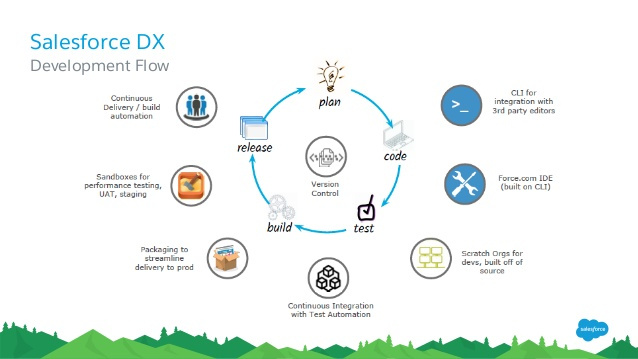Salesforce DX is a mighty product in the App cloud work environment. It will help the functional application developers to build and manage Salesforce apps with a fresh approach and streamline the entire SDDL (Secure Software Development Lifecycle).
Salesforce DX is an excellent platform, which had proven results in enhancing productivity levels and also improve collaboration between development environments for better control.
Salesforce platforms don’t have any version control system in-built, and so the latest DX came into the picture. With the addition of version control, now Salesforce DX enables the developers to manage the auditing of their projects better and do disaster management efficiently.
DX also enable developers to custom build and release the latest features in a very short span of time with minimal effort and minimal risks.
How does Salesforce DX work?

The latest Salesforce DX suite is created using the best of the Force.com, and Heroku Flow attributes with many enhancements. DX primarily operates with the help of the migration tools of Force.com in order to push the metadata operations and retrieve it from the Org.
Salesforce DX also leverages the Heroku Flow in order to effectively deliver the application pipelines and integration for better workflow restructuring.
Altogether, DX makes development more effectively by synchronizing the manual actions of developers and the automated functions to create better workflows.
The most notable features of new Salesforce DX are:
- Scratch Orgs
- Salesforce’s CLI (Command Line Interface)
- Source Sync
- Test Runner
- Continuous Integration
- A brand-new Force IDE
- DX support
In the above-mentioned new features of DX, Scratch Orgs is one of the most interesting and rewarding options. While the developers are building projects, many follow the appropriate development practices. For example, developing sandbox without version control feature could be a difficult approach.
It doesn’t matter if developers hold these by their own, but it may become incompatible with the version control soon when they try to switch the active branches.
Scratch Orgs
Scratch Orgs will help avoid such problems developers may face. With the assistance of Scratch Orgs, one can create new Orgs quickly by using the JSON configuration commands. This fits ideally with the workflow of the branch where the developers can easily branch their features and create a Scratch org to deploy and develop it.
They may also delete it later after finishing the creation. Effective management of Scratch Orgs can also be automated by using CLI commands. So, at the end of the day, a typical Salesforce environment will entail a metadata or Salesforce code which can be built or destroyed at the developer’s discretion. Altogether, Scratch Org helps to accelerate the developmental workflow.
Pros and Cons of Salesforce Dx
Salesforce is the most popular cloud computing enterprise SaaS (software-as-a-service) provider, with a fair collection of many development tools in the cloud. In the latest model of Salesforce DX, Production Org is the actual source of code, customization, and configurations as described by Flosum.com. The releases and updates are weaved and scoped to Production Org initially.
On the positive side of this development approach, the teams which are familiar with conventional development lifecycle, but it may be quite difficult to coordinate with the team as the version control doesn’t have seamless capacities. In addition to it, this model also won’t support a continuous integration of agile methodology.
Moreover, it could be difficult to automate the testing process. The roll-back of releases may also be made difficult in terms of the need for creating separate version modules. This is where Salesforce DX can come into help.
Salesforce DX offers the users:
- An improved VCS (Version Control System) with synchronization to the change-tracking of the setup features. It will let the developers have a fair grip on collaboration, audit, and disaster management.
- Ability to enhance time and quality to market through a CI (Continuous Integration) approach and CD (Continuous Delivery)
- Fine-tuned clarity and visibility in terms of change management of Production Org.
- Better ability to practice a more agile release management process.
In any case, Salesforce DX also has its own pros and cons as like any other technology tool.
Pros:
- Salesforce DX can now improve the collaboration in a team development environment and make projects run fast and smooth.
- It better facilitates automation testing and also a continuous integration
- Helps to make release cycles quicker, efficient, and agile.
- Developers can create an Org and then transfer all the application source as well as metadata into it from GitHub.
- Setting up a local development work-space which can be deleted later after implementation, which makes the task easier for the developer.
- Open technology which can be customized for user needs.
- Flexibility to use any tool in order to manipulate the code as CLI, Sublime, Vim, Atom, etc.
Cons:
- Salesforce DX is a comparatively new release from the provider, which still misses some essential features. Users frequently encounter bugs which could be fixed over time as Salesforce is keen on releasing adequate patches.
- For the users, there is a significant learning curve, which may make it a bit time-taking for them to get accustomed to the new mode of the development cycle and different technology.
- Troubleshooting Salesforce with the use of search engines will be difficult.
- Salesforce DX demands a heavy usage of command line instructions, which needs a different approach from the system admins.
The major advantage of Salesforce DX is that Testing and development can be fully automated as the Scratch Org is custom configurable based on the priorities of the developers.
Therefore, it is possible to manipulate the features and preferences can be set as per the needs of your present development environment.
Salesforce DX offers a standard kit of application for every developer. Developmental experience can be enhanced with the help of these tools. Open sources also are recognized in Salesforce, which lets the integration of application and helps to ease the software development process.
Final Words
As we’d seen above, it’s a CLI-centric approach which lets the developers manage metadata to hand down the applications easily. The entire development process is source-driven, which helps better management of the application life cycle.
Developers who are engaged in software construction hold the software solutions provided by Salesforce in high regard which undoubtedly attests the reputation of this service provider.
Read Also:
- Modern Commercial Challenges: What Works in Sales Management and What Doesn’t
- A New Type of Sales: How to Market to Your Consumers by Being Useful
- Amalgamation of Email Marketing and Instagram can augment your Sales Revenues
- How To Track And Validate Website Sales Leads
Author Bio: Evans Walsh
















